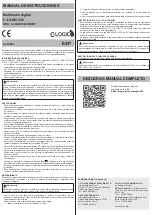
5. MAINTENANCE
5.0.
This section provides basic maintenance information, including fuse and battery replacement instructions.
Do not attempt to repair or service your Meter unless you are qualified to do so and have the relevant
calibration, performance test, and service information.
5.1. General Maintenance
To avoid electrical shock or damage to the meter, do not get water inside the case. Remove
the test leads and any input signals before opening the case
Periodically wipe the case with a damp cloth and mild detergent. Do not use abrasives or solvents.
Dirt or moisture in the terminals can affect readings.
To clean the terminals:
Turn the meter off and remove all test leads.
Shake out any dirt that may be in the terminals.
Soak a new swab with a cleaning and oiling agent (such as WD-40).
Work the swab around in each terminal. The oiling agent insulates the terminals from moisture-related
contamination.
5.2. Fuse replacement
Before replacing the fuse, disconnect test leads and/or any connectors from any circuit under
test. To prevent damage or injury replace the fuse only with specified ratings.
1. Power off device.
2. Disconnect test leads and/or any connectors from the terminals.
3. Use a screwdriver to unlock the 2 screws on the battery cover.
4. Take out the battery cover from the meter.
5. Remove the fuse by gently prying one end loose, then sliding the fuse out of its bracket.
6. Install the replacement fuses only with specified ratings: F 0.63A/1000V Ø10.3x38 and F 10A/1000V
Ø10.3x38
7. Rejoin the battery cover and tighten the screws.
5.3. Battery replacement
To avoid false readings, which could lead to possible electric shock or personal injury, replace
the battery as soon as the battery indicator (
) appears.
Before replacing the battery, disconnect test leads and/or any connectors from any circuit under
test, turn the meter off and remove test leads from the input terminals.


































